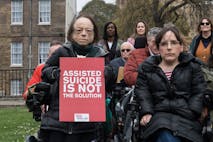
Poll: More UK medical professionals oppose assisted suicide bills than support
Right to Life UK
·
Vermont will allow non-residents to die by assisted suicide in the state
On Tuesday, Vermont became the first state in the nation to alter its physician-assisted suicide law to allow non-residents to come to the state to die by assisted suicide.
Gov. Phil Scott signed a bill into law that removes the residency requirement that was included in the original assisted suicide law. The bill was approved after the state agreed to allow a Connecticut woman with cancer to travel to Vermont to die. While Oregon has stopped enforcing its residency requirement for assisted death, the legislature has not officially removed it from the state law.
Mary Hahn Beerworth, executive director of the Vermont Right to Life Committee, testified before a legislative committee in March, saying that physician-assisted death “was, and remains, a matter of contention.”
“To be clear, Vermont Right to Life opposed the underlying concept behind assisted suicide and opposes the move to remove the residency requirement as there are still no safeguards that protect vulnerable patients from coercion,” said Beerworth. According to AP News, she has concerns including what liability Vermont could incur if the drugs failed to end a patient’s life.
While assisted suicide advocates in the state claim the law has many safeguards, it has become clear that such laws often begin with regulations, but eventually, those rules are relaxed over time to allow virtually anyone to request and be approved for doctor-induced death. In Canada, individuals with non-life-threatening disabilities have been pressured to die and the nation is considering allowing individuals with a mental health diagnosis to access assisted death. In the Netherlands, a legal loophole could allow children of all ages to be killed.
Kim Callinan, president and CEO of Compassion & Choices, a nonprofit pro-euthanasia advocacy organization, said, “We are grateful to Vermont lawmakers for recognizing that a state border shouldn’t determine if you die peacefully or in agony.” However, there is evidence that death by assisted suicide is not at all peaceful.
Dr. Joel Zivot, an associate professor of anesthesiology and surgery at the Emory School of Medicine, is considered an expert on “physician participation in lethal injection.” He campaigns against the use of lethal injection for executions in the United States due to the suffering it causes. In an op-ed for The Spectator, Zivot points out that assisted suicide actually brings about a painful — not painless — death.
Article continues below
Dear Reader,
Have you ever wanted to share the miracle of human development with little ones? Live Action is proud to present the "Baby Olivia" board book, which presents the content of Live Action's "Baby Olivia" fetal development video in a fun, new format. It's perfect for helping little minds understand the complex and beautiful process of human development in the womb.
Receive our brand new Baby Olivia board book when you give a one-time gift of $30 or more (or begin a new monthly gift of $15 or more).
“The death penalty is not the same as assisted dying, of course. Executions are meant to be punishment; euthanasia is about relief from suffering,” he said. “Yet for both euthanasia and executions, paralytic drugs are used. These drugs, given in high enough doses, mean that a patient cannot move a muscle, cannot express any outward or visible sign of pain. But that doesn’t mean that he or she is free from suffering.”
Zivot referred to the case of Marcus Wellons, who was executed using the same drugs frequently used in assisted suicide.
“Wellons’ autopsy revealed that his lungs were profoundly congested with fluid, meaning they were around twice the normal weight of healthy lungs,” he said. “He had suffered what is known as pulmonary edema, which could only have occurred as he lay dying. Wellons had drowned in his secretions. Yet even my medical eye detected no sign of distress at his execution.”
In addition, research has shown that painful and prolonged death from assisted suicide and euthanasia are not rare. A third of patients will take 30 hours to die, according to a study in the journal Anaesthesia, while a small number took seven days to die.
Zivot concluded, “Advocates of assisted dying owe a duty to the public to be truthful about the details of killing and dying. People who want to die deserve to know that they may end up drowning, not just falling asleep.”
Live Action News is pro-life news and commentary from a pro-life perspective.
Contact editor@liveaction.org for questions, corrections, or if you are seeking permission to reprint any Live Action News content.
Guest Articles: To submit a guest article to Live Action News, email editor@liveaction.org with an attached Word document of 800-1000 words. Please also attach any photos relevant to your submission if applicable. If your submission is accepted for publication, you will be notified within three weeks. Guest articles are not compensated (see our Open License Agreement). Thank you for your interest in Live Action News!

Right to Life UK
·
Guest Column
Right to Life UK
·
Issues
Bridget Sielicki
·
International
Cassy Cooke
·
Issues
Sheena Rodriguez
·
Human Interest
Nancy Flanders
·
Human Interest
Nancy Flanders
·
Investigative
Nancy Flanders
·
Pop Culture
Nancy Flanders
·
Human Interest
Nancy Flanders
·
Human Interest
Nancy Flanders
·